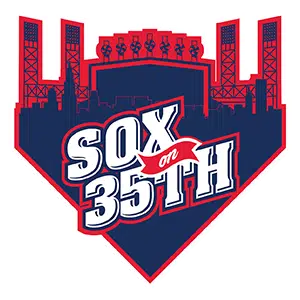When 2021 Spring Training began, Reynaldo Lopez and Carlos Rodon were locked in a battle for the fifth spot in the White Sox’ rotation. A stellar Spring Training from Carlos Rodon led to him winning the spot, and the rest is history there.
As for Lopez, he spent most of this season in AAA, going 1-6 with a 7.62 ERA as a starter with a 26.5% K-Rate and 11.1% BB-Rate. Though Lopez did post a 4.49 FIP over that span, indicating some poor luck, the move by the White Sox to call up Lopez on July 16 didn’t inspire much confidence.
Lopez, working only as a reliever in the majors this season, has been like the Reynaldo Lopez the White Sox expected when they traded for him back in 2016. In 14 IP, Lopez has a 1.29 ERA, 2.69 xERA, 3.30 FIP, 30.6% K-Rate, and 4.1% BB-Rate. In simpler terms: he’s been awesome, and Reynaldo Lopez stans are excited again.
The obvious question is obvious: has Reynaldo Lopez made legitimate improvements? Are we seeing a new and improved Reynaldo Lopez? And, if we are, what’s changed? We will explore this and more in this article.
Let’s begin.
What Needed to Change for Lopez
Before getting into the changes Lopez made, let’s focus on some of the things that were important for Lopez to fix:
- Lopez needed to add some life to his fastball. Among 200 qualified pitchers in 2020, Lopez ranked 164th in average spin rate on his fastball. A flat fastball can be hammered, and in 2020 for Lopez, it was: .327 BA, .633 SLG, .455 wOBA
- He needed a respectable secondary pitch. His slider tended to be a cement mixer more often that not, with very little horizontal and vertical movement. Hitters responded accordingly: .235 BA, .618 SLG, .367 wOBA.
- There were some mechanical things that Lopez needed to clean up. His arm action tended to get too long, knocking his mechanics out of whack and eventually leading to a walk rate that was the highest of his career (12.4%).
In short, Lopez cleaning up his mechanics would likely go a long way in helping his pitch shaping as well. Consistency in mechanics and a focus on getting on top of his pitches would go a long way.
I fit this all in a tweet back at the end of the 2020 season.
Now, to get to the improvements.
Improvement #1: Lopez’s Mechanics
The first area Lopez has made some slight adjustments is in the aforementioned mechanics. Let’s first take a look at the video from 2020 and 2021 – in the first combined video, 2020 Lopez is wearing the 1983 throwbacks.

As we learned in my Dylan Cease article, I’m not an iMovie wizard. So, let’s look at the video again, this time side-by-side:

2020 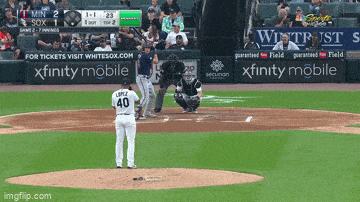
2021
Notice any differences? Here’s a few I can point out:
- Remember the shortened arm path we discussed before? It’s slight, but you can see it here. He creates more of an angle with his arm in the 2021 mechanics – whereas in 2020, his arm creates more of a full circle.
- The importance of #1 shows in the difference between where the ball ends up. Lopez’s arm in 2020 wasn’t catching up to the rest of his body, creating a situation where his arm drags behind the rest of his body and the ball flies to the backstop. In 2021, his arm moves well with his body.
- Lopez also drives down the mound a lot more in 2021 – he is coming through and using his back leg a lot more.
Do these takeaways hold in the data? Let’s take a look at his release point in 2020 and 2021:


Based on what we saw above, this information isn’t incredibly surprising. We’re seeing a slight shift in horizontal release point for Lopez, but a dramatic decrease in his vertical release point. This decrease in vertical release point is likely because of #3 above – he’s driving down the mound further.
What’s important about the above scatter plot of release points is the variances – the variances are in the vertical direction this season, not in the horizontal direction. This is important because it means Lopez is staying on top of his pitches more, which as we will see in a bit, has an effect on the shape of his pitches.
But, so far, so good with mechanics. There have been legitimate improvements for the first time in his big league career.
Improvement #2: Changes in Pitch Shape
“Pitch Shape” broadly refers to how the pitches look. Is there a lot of ride on your fastball? How much do your offspeed pitches move horizontally and vertically? Is there a noticeable difference between your fastball and changeup? Questions like these make up pitch shaping.
Lopez has been mostly a fastball-slider pitcher since coming up in 2021: 55% fastballs, 37% sliders. We are going to look at Lopez’s three main pitches – fastball, slider, and curveball – individually, but we will reference the following two graphics multiple times: Lopez’s changes in spin rate and changes in horizontal and vertical movement.
Graphic One: Spin Rate Changes

Graphic 2: Changes in Horizontal and Vertical Movement on Pitches

2020 
2021
Fastball
Let’s start with a couple graphics on Reynaldo Lopez’s fastball. Remember what we are looking for: an increase in vertical movement through improved mechanics and, as a result, improved command.
Graphic #3: Lopez Fastball Location by Season (2020 on Left)

2020 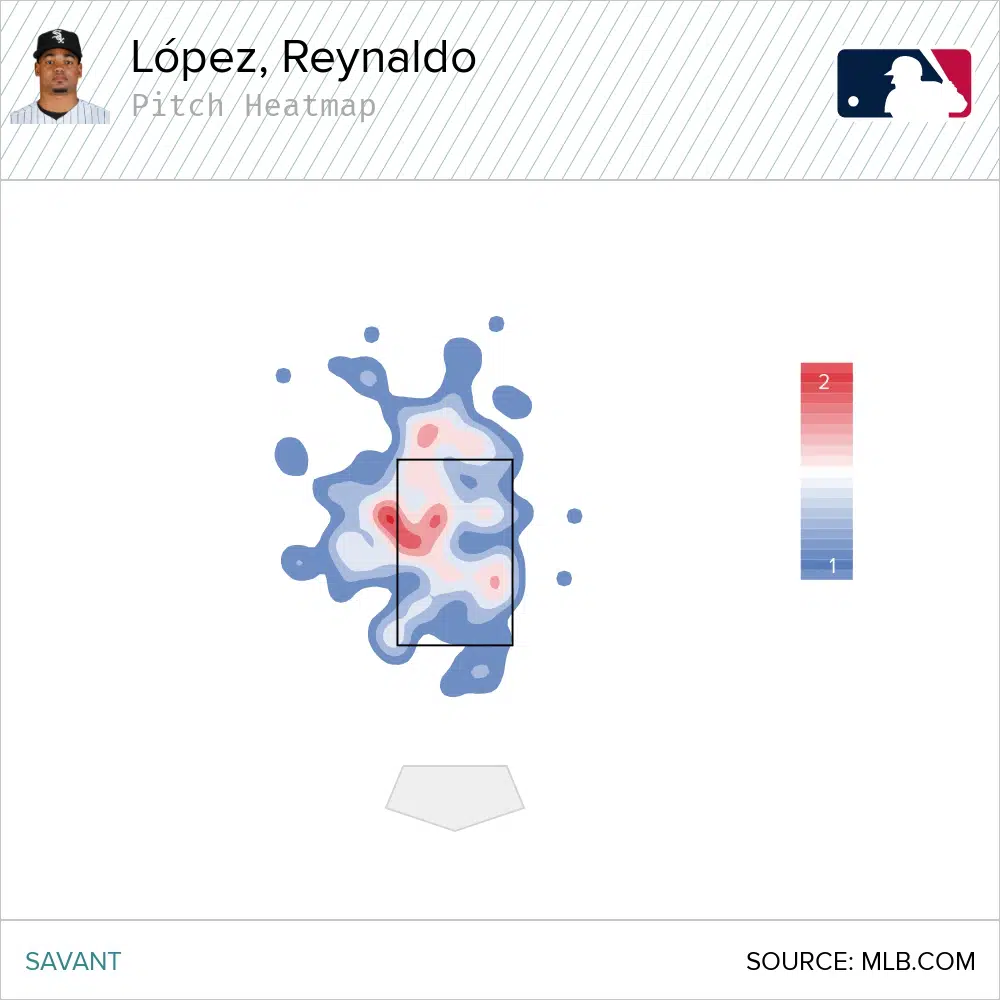
2021
Graphic #4: Vertical Movement by Pitch by Season
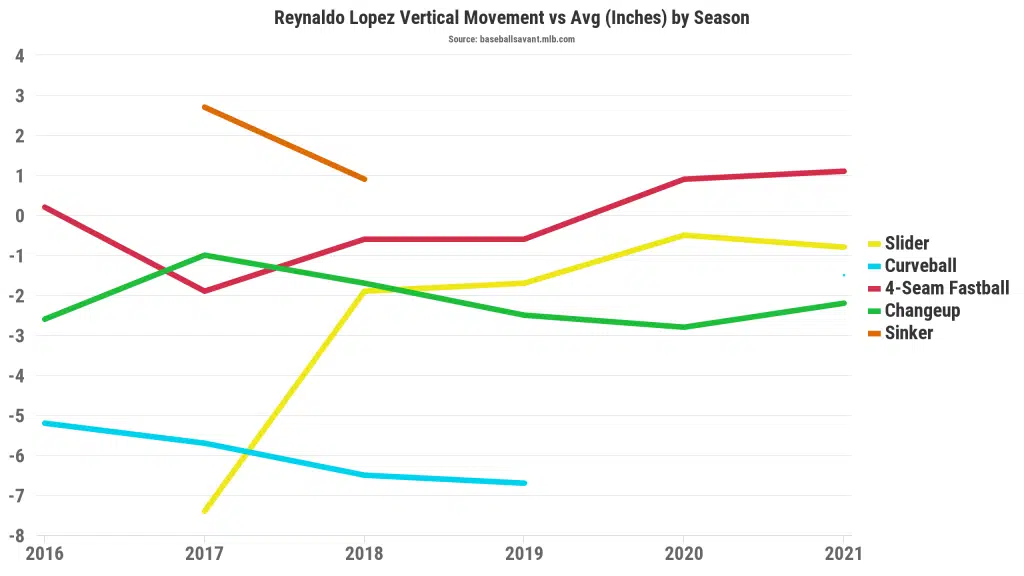
Alright, so we see serious improvement here. Lopez made a living with his fastball in the middle of the plate in 2020 – however, in 2021, it appears Lopez is working more towards the inside corner of the plate with his fastball (improved command). Additionally, there’s some more “life” on Lopez’s fastball – 8% more than average compared to similar fastballs. This has been accompanied by an increase in spin rate that we see in Graphic #1 above – an increase of approximately 90 rpm’s on his average fastball. This isn’t a huge difference, but Lopez is clearly getting more out of his fastball in 2021. As we see in Graphic #2 above, there’s less variance in horizontal movement in 2021 – meaning Lopez is staying on top of his fastball more.
The results show this as well. This season, hitters haven’t squared up his fastball at all: .125 BA, .208 SLG, .176 wOBA. The expected statistics – which are based off of quality of contact – show legitimate improvement: .188 xBA, .273 xSLG, .226 xwOBA. The 28.1% Whiff Rate on his fastball is up from 21% in 2020 as well.
So, to review. More “rise” on his fastball? Check. Improved command? Check.
Slider
The changes to Reynaldo Lopez’s slider – I would argue – are the most important changes to his arsenal we’ve seen this year.
To start, let’s take a look at a couple of sliders from 2020 and 2021.

2020 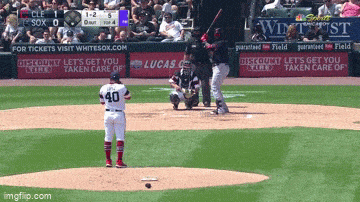
2021
The home run to David Bote was the typical example of a Reynaldo Lopez slider in 2020 – an absolute cement mixer that really doesn’t do much. It doesn’t move at all horizontally, and it doesn’t move nearly enough vertically either.
Enter Lopez’s 2021 Slider: sharper, more movement, better location.
Graphic #5: Lopez Slider Location by Season (2020 on Left)

2020 
2021
Graphic #6: Horizontal Movement by Pitch by Season
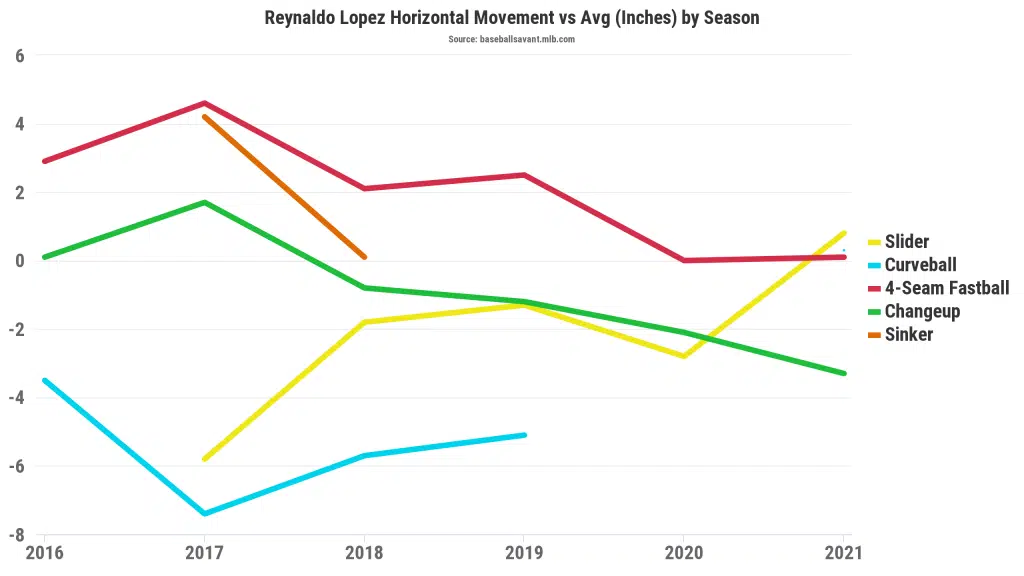
Um, yeah, that’s some serious improvement in pitch movement and location for Lopez’s slider. It now has 16% more movement than the average slider horizontally – which is absolutely awesome. Indeed, we see it from Graphic #2 above: the pitch is sharper and more consistent than in 2020.

2020 
2021
What’s the secret to this change? Well, it’s two-fold:
- Lopez is throwing his slider harder – the average speed this year on his slider is 86.5 mph, compared to 82.1 mph in 2020.
- Lopez has improved the tilt on his slider, as we can see below. It’s difficult to explain tilt, but here’s my best explanation: improved tilt helps to ensure Reynaldo Lopez is more consistently getting on top of his slider, which has turned it from a “cement mixer” that spins, but doesn’t really move, to a pitch that both spins and breaks down and away from hitters.
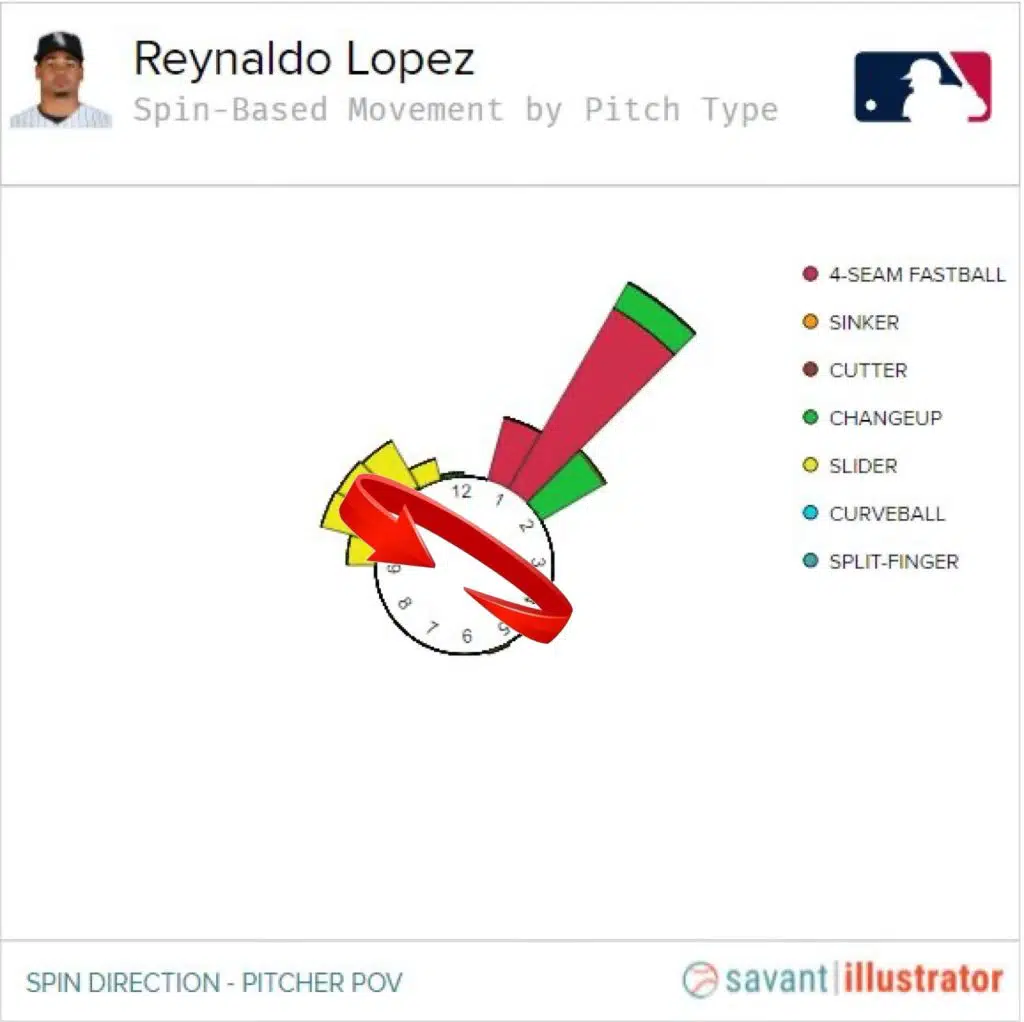
2020 
2021
The red arrows above show the difference in the spin axis on Reynaldo Lopez’s slider from 2020 to 2021. The spin axis is the direction in which the ball rotates in the air – and we use a clock to represent it (it’s why a “12-6” Curve is named as such). The spin axis on his fastball has changed from 10:00 to 10:45. The most important thing to understand here is that this change in the spin axis shows that Reynaldo Lopez’s slider has indeed changed since 2020 in an effective way with a focus on improved mechanics.
When looking at the raw spin totals for Lopez’s slider in Graphic #1, you’ll notice two things:
- He’s seen a slight incease in spin rate; but, more importantly
- He’s seen a 33% increase in active spin, which means a larger percentage of the spin on his slider is actually contributing to the movement of his slider. High active spin means less gyroscopic spin – in other words, less “meaningless” spin. The more meaningful spin a pitch has, the more it moves.

The results show this change in the effectiveness of his slider as well. Hitters are hitting just .188 off of Lopez’s slider with a .563 SLG and .290 wOBA. However, the expected stats (again, based on the quality of contact) show some good signs for that high SLG – .215 xBA, .398 xSLG, /285 xwOBA. This all goes along with a 27.5% Whiff Rate in 2021, similar to his 30.2% Whiff Rate on the pitch in 2020.
I can’t understate just how important this change in the pitch shape of Lopez’s slider is to his early success.
Curveball
The curveball and changeup haven’t been big pieces of Lopez’s arsenal this year, but I wanted to give you a glimpse of at least the curveball, for reasons we will discuss shortly.

In general, it’s a solid pitch for one he hasn’t thrown consistently in a very long time. It has nice break, and at worst, could be a quality get-me-over pitch early in the count.
Reynaldo Lopez did not throw his curveball in 2020 – in fact, according to Lopez and Ethan Katz in the below video, the organization thought it best to get rid of Lopez’s curveball (his best secondary pitch) when he came to the organization.
Now, why Don Cooper and the rest of the organization told him to drop it is a discussion for a different article. However, Ethan Katz and crew have brought it back – and made some drastic improvements to it, by first glance.

I had to do a double-take when I read the average spin rate in 2021 – almost 500 rpms more in 2021?!? For context, that ranks about 70th in terms of average spin across 160 pitchers – so it’s not elite by any means, but it’s a very quality pitch. To add that much pure spin on the pitch as well goes right along with the mechanical changes we discussed before: get on top, drive down the mound, and pull down hard.
Because he has thrown it so sparingly in 2021, there’s not much more to add here, other than a note to watch for it more as Lopez pitches more. It seems to be developing back into his arsenal, which is something to monitor moving forward.
The Verdict
Let’s quickly review what we’ve gone through here – as always, thanks for getting to this point!
- Heading into 2021, Lopez needed to make some serious changes. He needed more life on his fastball, more movement on his offspeed pitches, and cleaner/more consistent mechanics.
- Reynaldo Lopez, thus far in 2021, has accomplished all three of the things just laid out. He has improved life on his fastball by getting more “ride” and more movement on his slider with more “tilt”, both of which are a result of improved mechanics.
- Lopez’s improved mechanics have come through a shorter arm path and more use of his legs to drive down the mound. This has created more consistency/control in his pitches.
- Not only has Lopez made changes, but he’s followed improvements with results – an important step forward.
Out of the bullpen, Lopez has shown solid command and solid stuff, and as a result, gotten solid results. It’s absolutely great to see.
Now, here’s the big question: what role should Reynaldo Lopez serve in moving forward?
In my opinion, based on his heavy two-pitch usage in 2021 and his failure in AAA as a starter, I believe the organization has shifted their focus on Lopez into becoming an impact reliever, rather than an impact starter. Lopez will likely continue to make spot starts or tandem starts like the one we saw with Jimmy Lambert against Cleveland. However, the days of Reynaldo Lopez going 4-6 innings are likely over – and they should be.
In relief, Reynaldo Lopez can focus on just going all out for a couple of innings at a time, continuing to refine just two main pitches while adding a third and fourth offering (curveball and changeup) as get-me-over pitches to keep the hitter off-balance. If he can do this, he can be a pretty effective reliever/spot starter on any team. An emphasis on becoming a multi-inning reliever, however, should come with the end of his days of stretching out to be a starter. Sometimes, a guy’s stuff just plays better in the bullpen – which is the case of Lopez, who has good (but not great) stuff.
Credit to both Ethan Katz and Reynaldo Lopez – these are the sorts of changes I’ve been calling for Lopez to make for a couple of seasons now. It shows a willingness on Lopez’s part to improve, and a knowledge on Katz’s part to identify the necessary changes.
Not every prospect will work out exactly as we hope – many considered Lopez to be an incredibly underrated future starter of the original Adam Eaton trade. That being said, for Lopez to be able to contribute valuable innings at the major league level in any form is another sign of a pretty awesome trade way back in 2016. The Lopez stans should be happy about this one.
I’m encouraged by his growth – and I hope to continue to see more.
Have more thoughts on Lopez? Let me know in the comments or on Twitter! @jlazowski14
